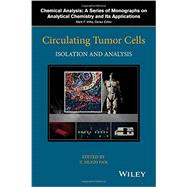Introduces the reader to Circulating Tumor Cells (CTCs), their isolation method and analysis, and commercially available platforms
- Presents the historical perspective and the overview of the field of circulating tumor cells (CTCs)
- Discusses the state-of-art methods for CTC isolation, ranging from the macro- to micro-scale, from positive concentration to negative depletion, and from biological-property-enabled to physical-property-based approaches
- Details commercially available CTC platforms
- Describes post-isolation analysis and clinical translation
- Provides a glossary of scientific terms related to CTCs








